Rear drum brake shoes - inspection and renewal
Caution: Refer to the precautions in Section 1 1 The shoe friction material can be inspected for wear without removing the roadwheels.
Working beneath the vehicle, prise the plug from the brake backplate, and using an inspection lamp or torch, check that the friction material thickness is not less than the minimum given in the Specifications.
2 If any one of the shoes has worn below the specified limit, the shoes must be renewed as an axle set (4 shoes).
3 To renew the shoes, slacken the rear roadwheel nuts, chock the front wheels, then jack up the rear of the vehicle and support on axle stands (see “Jacking and Vehicle Support”). Remove the rear roadwheels, and release the handbrake. On P100 models, mark the position of the roadwheels in relation to the brake drums before removal.
4 Proceed as follows according to model: 1.3 and 1.6 litre models 5 Remove the brake drum retaining spire washer(s) from the wheel stud(s) and remove the brake drum. If the drum will not pass over the shoes, it is possible to release the automatic adjuster mechanism by inserting a screwdriver through the small hole in the drum and pressing down on the ratchet (see illustrations).
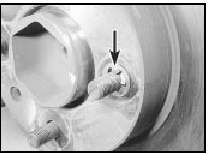
5.5a Brake drum retaining spire washer (arrowed)
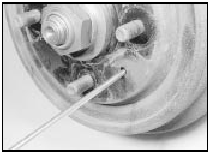
5.5b Releasing the automatic adjuster using a screwdriver
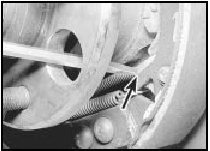
5.5c Drum removed showing screwdriver pressing on adjuster ratchet
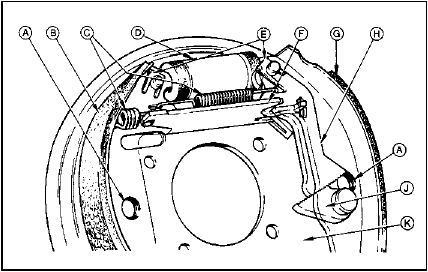
5.5d Rear drum brake self-adjuster assembly - 1.3 and 1.6 litre models
A Shoe hold-down points
B Trailing brake shoe
C Self-adjuster strut and top return springs
D Wheel cylinder
E Spring clips
F Self-adjuster strut
G Leading brake shoe
H Large ratchet segment
J Small ratchet segment
K Brake backplate
6 Using a wire hook or a pair of long-nosed pliers, remove the top and bottom shoe return springs. Note the fitted positions of the springs for reference when refitting (see illustrations).
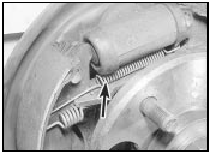
5.6a Top shoe return spring (arrowed)
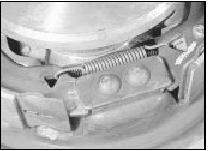
5.6b Bottom shoe return spring
7 Remove the hold-down cup, spring and pin from each shoe by depressing the cup and turning it through 90º (see illustration).
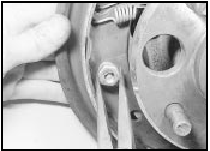
5.7 Using pliers to remove a shoe holddown cup
8 Pull the bottom of the leading (front) shoe towards the front of the vehicle so that the self-adjuster ratchets separate, then disengage the shoe from the strut by twisting it. Remove the shoe and adjuster mechanism.
9 Pull the trailing (rear) shoe away from the backplate far enough to gain access to the handbrake cable. Disconnect the handbrake cable from the lever and remove the shoe with strut and lever (see illustration).
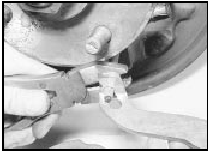
5.9 Disconnecting the handbrake cable from the trailing shoe lever
10 Clean and inspect all components, and lubricate the shoe contact points on the backplate (see illustration). Take care not to inhale any dust, as it may be injurious to health.
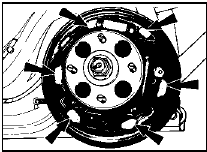
5.10 Lubrication points on brake backplate
11 Remove the strut from the trailing shoe by unhooking it from its spring. If a handbrake lever is not attached to the new shoe, remove the old lever by prising off the clip and driving out the pin. Use a new clip on reassembly (see illustration).
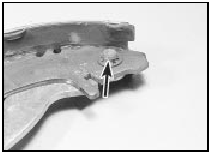
5.11 Handbrake lever-to-trailing shoe securing clip (arrowed)
12 Similarly transfer the self-adjuster components to the new leading shoe. Note that a small clearance (0.2 mm/0.008 in) must exist between the underside of the smaller ratchet segment and the brake shoe web.
Insert feeler blades of the correct thickness beneath the ratchet when fitting the spring clip, then withdraw the blades (see illustration). The larger segment should be fitted without any clearance.
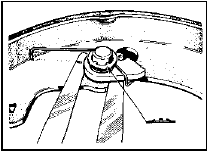
5.12 Using feeler blades to set clearance between smaller ratchet segment and
brake shoe web. Spring clip arrowed
13 Commence reassembly by engaging the self-adjuster ratchet teeth as shown (see illustration).
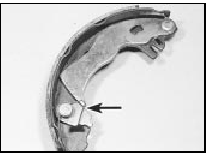
5.13 Fully retract the self-adjuster ratchet (arrowed) before refitting the
trailing shoe
14 Offer the trailing shoe to the backplate, fitting the handbrake cable to the handbrake lever and (if not already done) the strut and spring to the top of the shoe (see illustration).
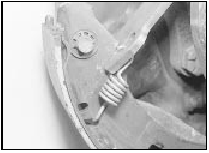
5.14 Strut and spring fitted to top of trailing shoe
15 Fit the leading shoe and adjuster mechanism, engaging the hole in the adjuster with the hook on the strut (see illustration).
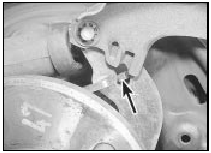
5.15 Engage the hole in the adjuster with the hook on the strut (arrowed)
16 Fit the top and bottom return springs: this is most easily done by allowing the ends of the shoe to pass in front of the wheel cylinder and the bottom pivot point, then engaging the shoes in their correct positions after the springs have been fitted. Be careful not to damage the wheel cylinder rubber boots.
17 Fit and secure the hold-down pins, springs and cups.
18 Back off the self-adjuster mechanism, by depressing the lower (small) ratchet segment, to enable the brake drum to pass over the shoes. Centre the shoes relative to the backplate.
19 Refit the drum, making sure that the small hole is in line with one of the two large holes in the drive flange. Secure the drum by pushing the spire washer(s) over the wheel stud(s).
20 Have an assistant operate the footbrake several times: a series of clicks should be heard from the drum as the self- adjuster mechanism operates. When the clicking no longer occurs, adjustment is complete.
21 Renew the brake shoes on the other side of the vehicle, then check the handbrake adjustment.
22 Refit the roadwheels, lower the car and tighten the wheel nuts.
23 Avoid harsh braking if possible for the first hundred miles or so until the new linings have bedded in.
1.8 and 2.0 litre models 24 Proceed as described in paragraph 5, but on P100 models mark the position of the brake drum in relation to one of the wheel studs (see illustration).
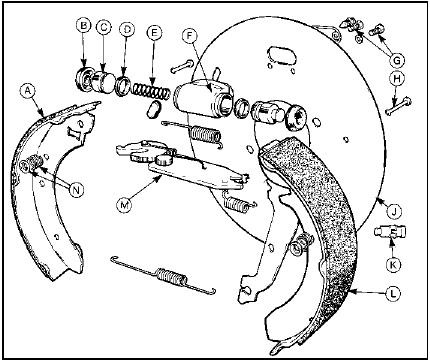
5.24 Exploded view of rear drum brake assembly - 1.8 and 2.0 litre models
A Leading brake shoe
B Dust-excluding seal
C Piston
D Piston seal
E Spring
F Wheel cylinder housing
G Bolts
H Hold-down pin
J Brake backplate
K Adjuster plunger
L Trailing brake shoe
M Self-adjuster strut
N Hold-down spring and cup
25 Remove the hold-down cup, spring and pin from the leading (front) shoe by depressing the cup and turning it through 90º (see illustration).
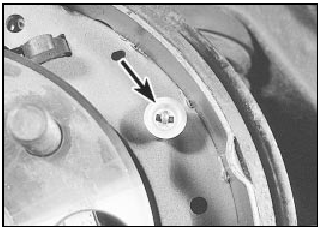
5.25 Leading shoe hold-down cup (arrowed)
26 Note the fitted positions of the shoe return springs for reference when refitting, then release the leading shoes from the wheel cylinder and the anchor bracket using a screwdriver as a lever.
27 Unhook the return springs and remove the leading shoe. Note the direction of wheel rotation arrows on the shoes.
28 Remove the hold-down cup, spring and pin from the trailing (rear) shoe by depressing the cup and turning it through 90º.
29 Withdraw the trailing shoe and disconnect the handbrake cable from the lever (see illustration).
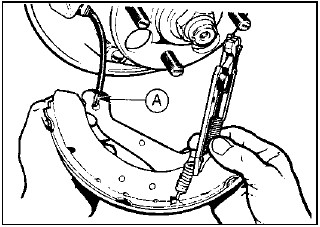
5.29 Removing the trailing brake shoe
A Handbrake cable and slot
30 Unhook the springs from the trailing shoe and remove the self-adjuster strut.
31 Clean and inspect all components and lubricate the shoe contact points on the backplate - refer to illustration, paragraph 10.
Take care not to inhale any dust, as it may be injurious to health.
32 Commence reassembly by fitting the springs to the trailing shoe and attaching the self-adjuster strut.
33 Attach the handbrake cable to the lever and position the trailing shoe on the wheel cylinder and anchor bracket. Ensure that the upper return spring is located on the self-adjuster strut.
34 Refit the hold-down pin, spring and cup to the trailing shoe.
35 Connect the return springs to the leading shoe, then locate the lower end in the anchor bracket and lever the upper end onto the toothed quadrant lever and wheel cylinder. Be careful not to damage the wheel cylinder rubber boot.
36 Refit the hold-down pin, spring and cup to the leading shoe.
37 Using a screwdriver, push the self-adjuster toothed quadrant fully towards the backplate to its initial setting.
38 Proceed as described in paragraphs 19 to 23 inclusive, but on P100 models, align the previously made marks on the brake drums and wheel studs, and on the roadwheels and brake drums.
See also:
Cylinder head and pistons - decarbonising
1 With the cylinder head removed as
described in Section 7, the carbon deposits
should be removed from the combustion
surfaces using a blunt scraper. Take great
care as the head is of light alloy ...
General information and precautions
The fuel system on all models with
carburettor induction is composed of a
centrally mounted fuel tank, a fuel pump, a
carburettor and an air cleaner.
The fuel tank is mounted under the floor
pan ...
Cylinder block and bores - examination and renovation
1 The cylinder bores must be examined for
taper, ovality, scoring and scratches. Start by
examining the top of the bores; if these are
worn, a slight ridge will be found which marks
the top of the ...
